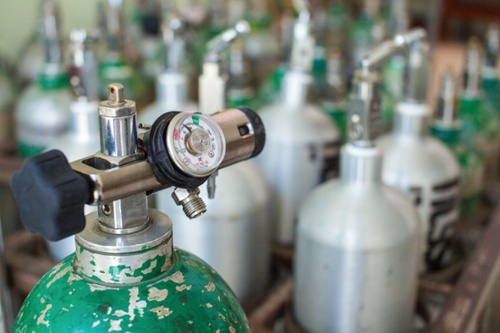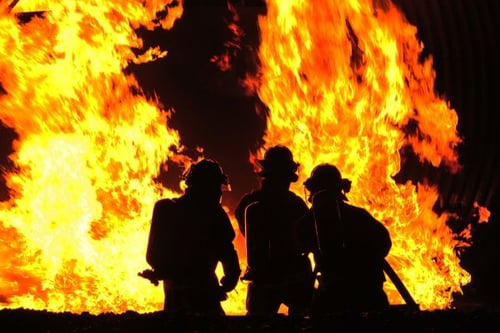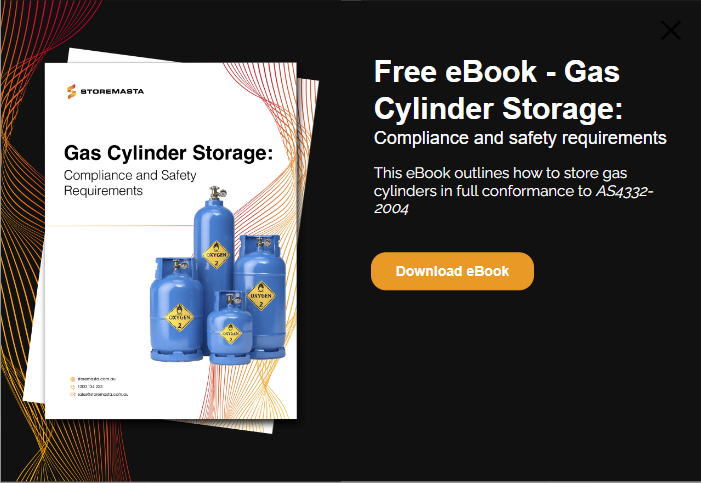As Class 2.3 Toxic Gases, corrosive gases have the potential to burn or destroy organic tissue. When storing and handling these hazardous gases in the workplace, it’s essential that you follow all the necessary precautions, so your staff remain safe and well. In this post, we take a closer look at the hazards presented by corrosive gases stored in cylinders. We’ll also explain how to segregate corrosive gases in your cylinder store and show you how you can handle them safely.
REMEMBER: Workplaces which hold compressed gases in cylinders must follow the guidelines of AS 4332 - The storage and handling of gases in cylinders. We’ll be referring to the relevant sections of the Standard to help your workplace reach compliance.
What is Corrosive Gas?
A corrosive gas can damage and destroy human tissue, as well as metal and other materials. The corrosive gas meaning applies to a broad range of compressed gases stored in cylinders. Corrosive gas is commonly used in workplaces for a variety of applications, such as manufacturing and chemical processing.
Which Gases are Corrosive?
While you should always refer to your Safety Data Sheet to determine which gases are corrosive, it’s also helpful to understand some examples of these Class 2.3 Corrosive Gases.
Our brief corrosive gases list includes commonly found examples such as:
- Hydrogen chloride
- Chlorine
- Nitrogen dioxide
- Sulfur dioxide
- Ammonia
- Methylamine
With both toxic and corrosive properties, it’s important to understand just how these gases can present harm in the workplace environment. We’ll go into detail about some of these hazards in the next section of our post.
Hazards of Corrosive Gases in Cylinders
Corrosive gases are used across a wide range of industries including oil, gas, paper making, and food preservation.
Corrosive gases such as ammonia, chlorine and sulfur dioxide are commonly found in the workplace. However, like all compressed gases, corrosive gases present a complex range of hazards.
This is because the chemical and toxic properties of the gases are compounded by the physical nature of the cylinders — and the fact they are compressed and stored under pressure.

Corrosive gas poses the risk of both chemical hazards, as well as physical hazards due to the compressed gas stored within the metal cylinder.
We’ll now discuss the various hazards that can arise from the storage and handling of corrosive gases in the workplace.
Toxic Dangers to People
Corrosive gases and vapours can cause harm to people when the gas in inhaled. Corrosive gas can quickly attack, burn and destroy living tissue and organic materials.
The eyes and respiratory tract are extremely sensitive and vulnerable to permanent injury. Once the toxins in the gas reach the bloodstream, they can penetrate major organs such as the lungs, liver, kidneys, as well as the reproductive and nervous systems.
Exposure to these gases can also result in chemical burns to the skin, due to the corrosive chemical that’s been accidentally released.
Exposure can be fatal and the severity of injuries are impacted by:
- Chemical properties and toxicity levels of the gas
- Length of time the worker is exposed to the gas
- Response times by first aiders, paramedics and hospital staff
- Other chemicals or Dangerous Goods present that may react with the gas
- Overall health of the exposed worker: things like their body weight, whether they were a smoker, if they had allergies
IMPORTANT: Safety Data Sheets (SDSs) for gases kept or handled on-site, and the appropriate first aid kit, must be kept in a readily accessible location. Section 5.2.1 (c) AS 4332: In the case of toxic and corrosive gases, compliant safety showers and eye wash stations will also be required.
Damage to Plant and Equipment
These dangerous goods can attack and corrode metals, causing damage to operating plant and equipment while reducing the lifespan of operating machinery.
In electrical power systems, the build-up of corrosion creates excess heat which can cause circuit breakers and motor starters to explode. Corroded gas cylinders can cause catastrophic leaks, chemical reactions and explosions.

Compressed gases, such as corrosive gas, can create an explosion if the work environment exposes the cylinder to excessive heat.
Toxic Hazards to the Environment
As corrosive gases can attack and damage any type of living tissue, they can also create environmental hazards if there is an accidental release in the workplace.
Some corrosive gases represent an acute toxic hazard to aquatic environments, while others can damage fauna, vegetation, and rural properties.
Physiochemical Hazards of Gas Cylinders
The long, slim design of gas bottles (plus the fact they are slippery and heavy) means they are vulnerable to falling or being knocked over.
The mechanical energy stored in any gas cylinder is comparable to a car travelling at 180 km/h, and each has the potential to explode if the cylinder is ruptured or overheated.
Hazards include:
- Escaping gas - accidental release from mishandling, worn fittings and connections, or corroded cylinders
- Ruptured cylinders - uncontrolled release or explosions from a cylinder being dropped/thrown, or impacted by a falling object, forklift or vehicle.
- Overheated cylinders - explosion after a cylinder is exposed to industrial heat, or dangerous event like a fire or explosion
Leaking cylinders that contain corrosive gas can cause fatalities and dangerous incidents very quickly. All gases under pressure can displace the oxygen in a room or confined space, and corrosive gases that are also flammable become an explosion risk.
ESSENTIAL: The Standard requires that all gas cylinders and their fittings be checked regularly for leaks. Section 5.2.1 (j) AS 4332.
Locating and Segregating Class 2.3
In your cylinder store, it’s crucial that you segregate Class 2.3 Toxic Gases (which include corrosive gases) from incompatible gases and substances, dangerous goods and ignition sources.
Make sure that your gas bottle stores are segregated in the following ways:
- Compressed Gases: Class 2.1 Flammable Gases and Class 2.2 (5.1) Non-toxic, Oxidising Gases must be stored at least 3 metres away. If this distance can’t be achieved, you can use a screen wall made from non-combustible materials and at least 1 metre higher than the tallest cylinder in either store.
- Combustibles: combustibles, refuse, and vegetation must be kept at least 3 metres away from cylinder stores.
- Buildings: cylinder stores should be located at least 1 metre from building openings: doors, windows, vents, ducting.
- Industrial Heat: make sure cylinders stores are kept clear of plant and equipment that generates heat; furnaces, machinery, radiators, boilers, steam pipes.
- Ignition Sources: any potential ignition sources must be kept away from cylinder stores. This includes cigarettes, lighters, personal electronics (and anything could generate static electricity), burners, welders.
Handling and Storing Corrosive Gases
There are some simple steps that you can follow to improve safety when you’re handling and storing gas cylinders.
However, make sure you always conduct a full risk assessment at your workplace to ensure that all gas cylinder hazards have been identified and properly controlled.
Use Mechanical Lifting Devices
Section 5.3.1 of the Standard requires that mechanical lifting devices, forklifts and cylinder trolleys should be used whenever gas bottles are being received, moved around the worksite, or returned to the supplier. Keep the valves protected and the cylinders upright.
Mechanical and manual lifting devices, such as a gas bottle trolley, can improve safety when handling compressed gas cylinders.
Use Cylinder Caps and Restraints
Store toxic and corrosive gases upright and keep them restrained using safety straps or a chain — it’s best to keep them in a secure cylinder store. The cylinder valves must be closed when in storage and all Class 2.3 toxic gas cylinders require gas-tight outlet caps or plugs fitted over their valves when not being used.
Wear Personal Protective Equipment
Wear suitable PPE that protects all exposed skin surfaces from contact with corrosive gases and vapours. These might include eye guards, face shields, overalls, gloves, and in some cases breathing apparatus.
Ventilate Cylinder Stores
The Standard requires that areas containing toxic and corrosive gases are always well ventilated. Workplace exposure standards must be maintained. And your stored gases must remain within explosive ranges, with oxygen levels remaining consistently safe.
To further control the emission of corrosive vapours, a mechanical ventilation system may be required. This system must be constructed and installed in compliance, with exhaust fans, fumes, ducting, alarms and monitoring controls.
Install Safety Showers and Eye-wash Stations
Even though you’re dealing with compressed gas in cylinders, your staff are still at risk of chemical exposure if the gas is accidentally released. To improve work health and safety, as well as maintaining compliance, you must ensure that you install emergency decontamination equipment in areas that store or handle corrosive gases.
A compliant safety shower and eye wash station should be installed in the work area, in addition to a a first aid kit and emergency PPE. Staff should be well trained in chemical emergencies knowing the location of the safety showers/eye-wash stations and how to use them.
Handling Class 2.3
Do you carry any toxic, corrosive or other compressed gases at your worksite? We recommend downloading our free eBook Gas Cylinder Storage: Compliance and Safety Requirements for a detailed look at how to create a safe and compliant workplace. It’s an excellent resource for WHS Managers and supervisors responsible for managing gas cylinders (and other dangerous goods) at the worksite.
Joining the team as a Dangerous Goods Storage Consultant, Melissa Hampton became Storemasta's Marketing Manager in late 2021. With extensive knowledge and experience in chemical compliance, Melissa is responsible for leading the Marketing team and helping shape their marketing strategy. In her spare time, you can find Melissa hiking, swimming and enjoying the great outdoors in beautiful north-west Tasmania.

